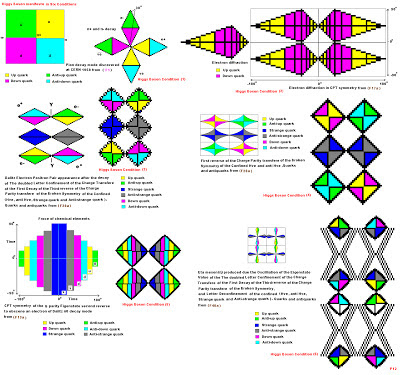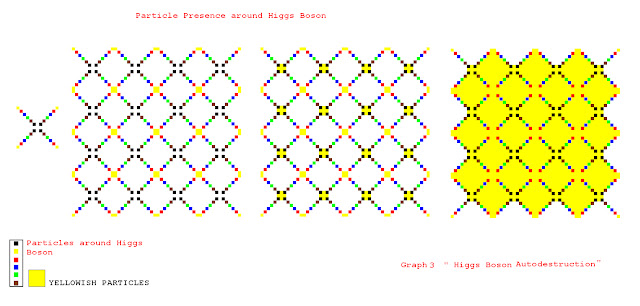I- Introduction
In this
post I would like to introduce you to the disinfection of the matrimonial
baggers of the Lithuanian microscopic sediments. The essential point in this
post is around Higgs boson mechanism;
means how, why, where, and when Higgs
boson exercises it's influence on other subatomic particles?
What we
already know is; that there are eleven nodes and eleven oscillators driven from
the suggested supersymmetry theory which I explained through drawings and
definitions published in earlier posts.
In
particle physics the most important paradox is the annihilation of particles
where quantum and momentum are conserved, the result of this paradox is the
genesis of new exotic particles.
Our
subject here is the objection of the insurrection of Higgs boson mechanism. The
main cause of the information below; which comes in two parts, a definition and
a drawing is to understand the correlation between the properties inside the
eleven oscillators.
Believe
it or not!! Everything is built on the base of a sinusoidal wave exactly the
same as the DNA; meanwhile the conjugation is the perfect key to discover the
world of electronics.
Now the
resolution is bright and clear to see Higgs boson as an oscillator. Please note
that in each time new information is acquired; a definition and a drawing will
be added to this post to explain our subject further more. And as long as
there is no conclusion yet; this post will be in a state of continuity.
II-
Definitions and Drawings
1-
A node: Is
a point along a standing wave where the wave has
minimal amplitude. For instance, in a vibrating guitar string, the
ends of the string are nodes; by changing the position of the end’s node
through frets, the guitarist changes the effective length of
the vibrating string and thereby the note played. The opposite
of a node is an anti-node; a point where the amplitude of the standing
wave is a maximum this occurs midway between the nodes.
2-
Oscillator: Oscillation is
the repetitive variation, typically in time, of some measure about a
central value (often a point of equilibrium) or between two or more
different states. Familiar examples include a
swinging pendulum and AC power. The
term vibration is sometimes used more narrowly to mean a mechanical
oscillation but sometimes is used to be synonymous with
"oscillation". Oscillations occur not only in physical systems but
also in biological systems and in human society.
3-
Acceleration: The special theory of relativity describes the behaviour of objects travelling
relatively to other objects at speeds approaching the speed of light in a
vacuum. Newtonian mechanics is exactly revealed to be an
approximation to reality, valid to great accuracy at lower speeds. As the
relevant speeds increase toward the speed of light, acceleration no longer
follows classical equations. As speeds approach the speed of light; the
acceleration produced by a given force decreases and becomes asymptotically small
as light speed is approached; an object with mass can approach this
speed asymptotically but never reach it.
4-
Energy and Matter, E = MC2: Energy can neither be created nor destroyed, and energy in all of
it's forms has mass. Mass also can neither be created nor destroyed and in all
of it's forms has energy. According to the theory of relativity; mass and energy
as commonly understood are two names for the same thing, and neither one is
changed nor transformed into the other. Rather, neither one exists
without the other existing also, as a property of a system. Rather than mass
being changed into energy the view of special relativity is; that rest mass
has been changed to a more mobile form of mass, but remains mass. In the
transformation process, neither the amount of mass nor the amount of energy
changes, since both are properties which are connected to each other via a
simple constant.
5-
The Sine Wave or Sinusoid: Is a mathematical curve that
describes a smooth repetitive oscillation. It is named after the
function sine. It occurs often in pure and applied mathematics, as
well as physics, engineering, signal processing and many
other fields. The sine wave is important in physics because it retains it's wave
shape when added to another sine wave of the same frequency and arbitrary phase
and magnitude. It is the only periodic wave form that has this property. This
property leads to it's importance in Fourier analysis and makes it
acoustically unique.
6-
Quarks Assumption: Is the state of quarks stability
due Higgs boson oscillation.
7- Correlation
Function: In statistical mechanics is a measure of the
order in a system, as characterized by a mathematical correlation
function, and describes how microscopic variables at different positions are
correlated. In a spin system; it is the thermal average of the scalar
product of the spins at two lattice points over all possible orderings.
8
- Free-Energy Relationship
or Linear Gibbs Energy Relation: In physical
organic chemistry, relates the logarithm of a reaction rate
constant or equilibrium constant for one series of reactions
with the logarithm of the rate or equilibrium constant for a related series of
reactions. Establishing free-energy relationships helps in the understanding of
the reaction mechanism for a chemical reaction and allows the
prediction of reaction rates and equilibrium constants.
9-
Higgs Boson Reconstructions: In addition “I know that the perception of
Higgs boson contradictions is influenceable by accuracy; means that the
conceptual is perfectionist. As human precision is incapable to detect these
occurrences of Higgs boson reconstructions, in spite of all technologies used
to understand it, it is still a mystery.” In condition “substrates are
subsequent of Higgs boson mechanism; means that the conceptual is definitely
right, because instead of limiting the conceptual, a serious investigation of
what it has been presented in this blog would be a wise reasoning”.
10-
Recreation of the Hypothetical Higgs Boson: We already know that Higgs boson is
an insulator (Please check “Ink and Diamond post”), what is fundamental is that
the assumption is equal to a sentinel in cryptology. Higgs boson insurrection
on physical laws is plausible upon the conjugated systems, where molecules are
joined through p-bonding; this explain the insulation of the universe and the
existence of holes where electrons, protons and gamma rays are free to travel
horizontally and vertically, nothing else is allowed to do so. On my experiment
on Rugosa corals (Higgs boson) the production of diamond was possible due the
joined gathering of carbon atoms through P-bonding; this represents a
conjugated system in itself. The invocation of letter conjugation in Figure (F22a) is a perfect explanation to Higgs boson insurrection and insulation.
11-
Higgs Boson Assumptions: Are the states where Higgs boson becomes stable, in
the figure bellow we can see (6) forms of assumption representing Higgs boson
stability.
12-
Higgs Boson Manifesto: Unconditional substrates are the key to innovation;
in addition “I think that the conception is a valuable thing, so the
interactions of the connected subatomic particles are due to Higgs boson
oscillation. The conception is decisive, metamorphic and soluble”.
13-
Higgs Boson Decoding: Is a substantial catenation to the aberration of the insulin.
14-
Higgs Boson Auto-Destruction:
14- 1 Particle
Connection around Higgs Boson: The availability of Higgs Boson is the
perfect way to understand it’s destruction; by looking at the graph shown
bellow we understand the composition and the manners of the cycle of the
particles participating in the destruction of Higgs boson.
The different colours used are taking places to show the connection of
these particles around Higgs boson. The list of the particles is indeterminate
yet, and is indefinite. As I said my experiment is still live and each time a
particle is generated; it’s addition will appear on future graphs. Remember
in the super symmetry the particles are spread in latitude and altitude manner.
14-2
Particle Influence on Higgs Boson: Systematic has a grand role in
defining the kind of particles which are around Higgs boson. Let’s suggesting
that the blue particles are “Mamers”; their number grows from (12) to (48). Now we
know that there are (48) different particles under different names and they
have different characteristics. Not only that but they can develop to the infinite.
In the first case “Bottom left” the commemoration is forbidden as it has a
straight link to Higgs boson.
14-3
Particle Presence around Higgs Boson: Particle Presence is an indirect
obstacle that permitting innovation of Higgs boson Cycle. The yellow particles
shown on the Graph (3) have an indefinite number; their participation in Higgs
boson Cycle is imminent, these are called “Yellowish Particles”.
14-4
Particle Physics Manipulation: Is a wonderful era of imagination of
Particle Physics beyond humans' knowledge. Thus manufacturing could take a
great advantage by opening their pockets in order to substitute the correlation
between particle Physics and the industrial world.
14-5
Higgs Boson Arrows: The constitution of Higgs boson is unknown and flat; meanwhile the
paparazzi are giants to human eye, the subject here is to suggest the idea
of Higgs boson Arrows; they are simple particles with red colour, they are
capable to transferee ammunition to the heart of Higgs boson, by this an
electromagnetic field is created. I also found that “Reddish” is a suitable
name to this kind of particles.
14-6
Higgs Boson Manifestation: Brownish Particles are supposed to be the first in
the trinity due to their colour charge.
III Conclusion
After all what it has been said is just a hypothesis in which the reader
may find a work of art. This post comes to it’s end, in consequence by joining
the matter at it’s end; accordingly frames are still under observation. The
question is; do we require a more sophisticated technology? I suppose yes.







































